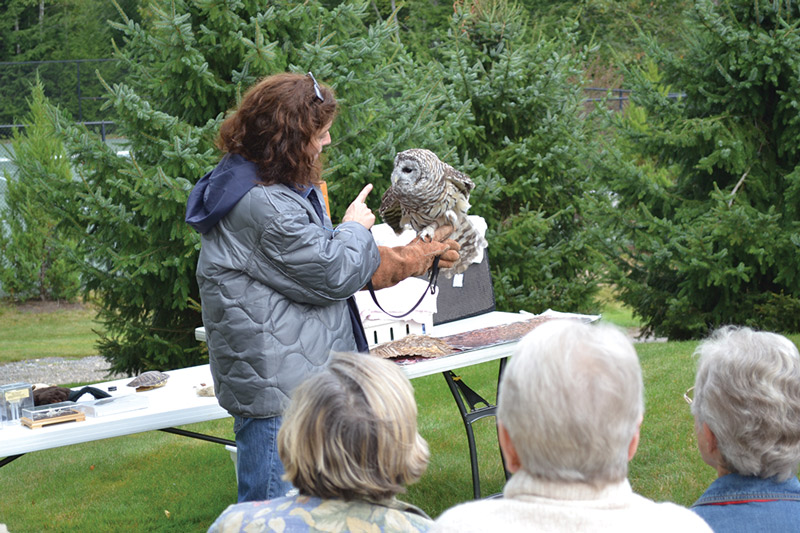“There was nothing here; there were no houses,” recalls Sally Von Benken of her first casually curious visit to Highland Green, a 55-and-up community in Topsham that is on the cusp of celebrating 20 years since its first residents arrived. Yet, by the end of their exhilarating Jeep tour, she and husband, Jim, agreed: “Man, we want this.” For Sally, an avid hiker, seeing the adjacent Cathance River Nature Preserve sealed the deal. “I just absolutely loved it,” she says. She would go on to help blaze some of the preserve’s earliest trails.

As Highland Green has grown, so too has its residents’ mutualistic relationship with the preserve and the Cathance River Education Alliance, which operates in its midst. The creation of both was the happy outcome of a big compromise at the outset of development: one that remains a fine example of Mainers resolving their differences by talking openly. Over coffee.
Owner John Wasileski’s original vision for Highland Green’s sprawling campus included an 18-hole championship golf course and homes that would stand within 250 feet of the Cathance River, which flows to Merrymeeting Bay. The river’s health has a direct impact on this freshwater tidal marsh, a habitat for rare plants, birds, and fish. John Rensenbrink, who’s always loved swimming in the Cathance, lives just downriver. A long-time Bowdoin professor of political philosophy and co-founder of the Maine Green Party and the Green Party of the United States, he rallied like-minded foes to protect this natural resource.
Sure, it took a while to hammer out details. But when John and John met for breakfast, they turned the tide in nature’s favor. The golf course was downsized to nine holes. The buffer between the river and construction was increased to 1,000 feet. And 230 acres became the Cathance River Nature Preserve, now managed by the Brunswick-Topsham Land Trust. Wasileski provided capital to co-found CREA with Rensenbrink, and the nonprofit’s public programs have since continually expanded, immersing kids and adults in ecological learning.

While more than five miles of trails are open to all, as are CREA’s guided walks and workshops, no community benefits more from the existence of this riverside sanctuary than Highland Green. Nor does any group show more appreciation for this gift of open space to explore.
CREA executive director Caroline Eliot easily rattles off the diverse ways in which the organization is supported by its Highland Green neighbors. Some serve as board officers and members; others give talks, lead walks, help with mailings, do carpentry work. One resident preps the fishing equipment for summer camps. Two women translate StoryWalk panels into Portuguese and French.
Stop by a CREA Ecology Center open house any Sunday between noon and 2 p.m., and you’re likely to meet knowledgeable volunteers: Highland Green’s residents include many former educators and professionals with rich and unique expertise. CREA board member Sue Reed, for example, retired from her role as early childhood specialist at the Maine Department of Education. She’s guided CREA educators in their work with Head Start preschoolers.

Dick Thomas, a Bates alum who moved from New Jersey to Highland Green three years ago with his wife, Anne Garty, has lent a hand with Ecology Center painting and trail maintenance . . . and appreciates being able to attend virtual programs and snowshoe in the winter woods. For those considering a move to Highland Green, he counsels that “in addition to the beautiful surroundings and the well-built homes,” there are a “multitude of things you can do, from the physical to the intellectual. You never have an excuse to be bored.”
Retired nurse Valerie Chow shoots photos for CREA and helped staff research and develop COVID guidelines. Her involvement has had positive ripple effects in her own life since she and her husband moved from Florida to Highland Green in 2004. Their shy grandson was a CREA camper for two summers, a counselor-in-training for two more. Outdoor learning and leading not only boosted his confidence and communication skills, “it played a significant role in his decision to go on to university and study environmental science,” she says.
Chow likes to take her camera to the preserve’s heath bog, where 124 bird species have been spotted. Not only did she “catch” Canada geese babies in their nest debut, “I saw them get into the water. I saw them swim away. I went every day.” When she followed them to the little pond nearby, where goslings learn to fly, “Papa looked at me and cocked his head as if to say, ‘You’re here again?’ I swear they recognized me.”
Enchanting moments like this inspire her to assure: “I’m never going to stop volunteering for CREA.”
What’s Next in the Evolution of Highland Green?
Newcomers are always welcomed warmly at “HG.” Original resident Sally Von Benken says “the people are still the main thing” that make living here a dream come true.
Home sites are available, and a Rent While You Build option allows relocators to sell while the market is hot.
In the future, residents will see more wellness, transportation, housekeeping, and dining services. The goal: peace of mind they’ll be able to remain healthy and happy in their Highland Green homes. A new Assisted Living and Memory Care facility will also be added to the campus.





